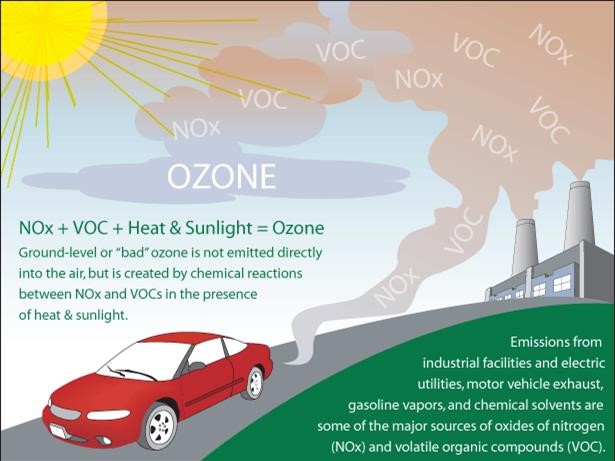Tropospheric vs Stratospheric Ozone
While many have heard of the ozone layer high up in the atmosphere that helps to shield the planet from solar radiation, ground-level ozone can cause adverse health effects at high concentrations…. So what exactly is ground-level ozone? Tropospheric ozone, or ground-level ozone, is considered a “secondary pollutant.” This means that ozone is not emitted directly from cars or industry, but forms when there are precursor emissions (such as oxides of nitrogen (NOx) and volatile organic compounds (VOCs)) that combine in the presence of heat and sunlight. In addition, light winds limit the vertical mixing of air and help to encourage the formation of ozone. We most often see high ozone days in the summertime when we are under a ridge of high pressure, where winds are light and there is sunshine-a-plenty!

Ozone Forecasting Overview
So how do air quality forecasters predict how much ozone will form? First, we prepare a meteorological forecast to help us determine how favorable the environment will be for the needed photochemistry–will there be clouds to help limit incoming sunlight? Will there be showers to help rinse the air from pollution? What does the vertical profile of the atmosphere look like, and will it inhibit dispersion? In addition to weather variables, we also look at what levels of ozone were seen in the preceding days and analyze where today’s air will be coming from. We will perform a back trajectory analysis to see if incoming air is originating from areas of heavy industrial activity. Air from these locations will often have elevated incoming background levels of precursor emissions or ozone (which could be high enough so even minimal local add-on can cause upper Code Yellow/Code Orange readings). We also have photochemical models that help to inform our forecast.

Ozone Alerts
Much like our PM2.5 forecast, we prepare a daily county-level forecast for the ozone AQI. When there is a favorable meteorological setup and high levels of ozone are expected to impact the region (Code Orange AQI or higher), we will issue an Air Quality Alert. You can help reduce precursor emissions by choosing to take the bus instead of driving, avoiding drive-through lanes or long periods of idling in your car, and using lawnmowers/chainsaws/etc that run on electricity instead of gas (or saving those chores until the evening!) on these days.
Please check our forecast page (https://xapps.ncdenr.org/aq/ForecastCenterEnvista) for more details regarding what’s happening with North Carolina’s day-to-day air quality, including a written discussion with the details that inform our forecast.
Is there something you’re wondering about with regards to Air Quality that you would like to see in future posts? Let us know in the comments!
 Air Quality Portal
Air Quality Portal